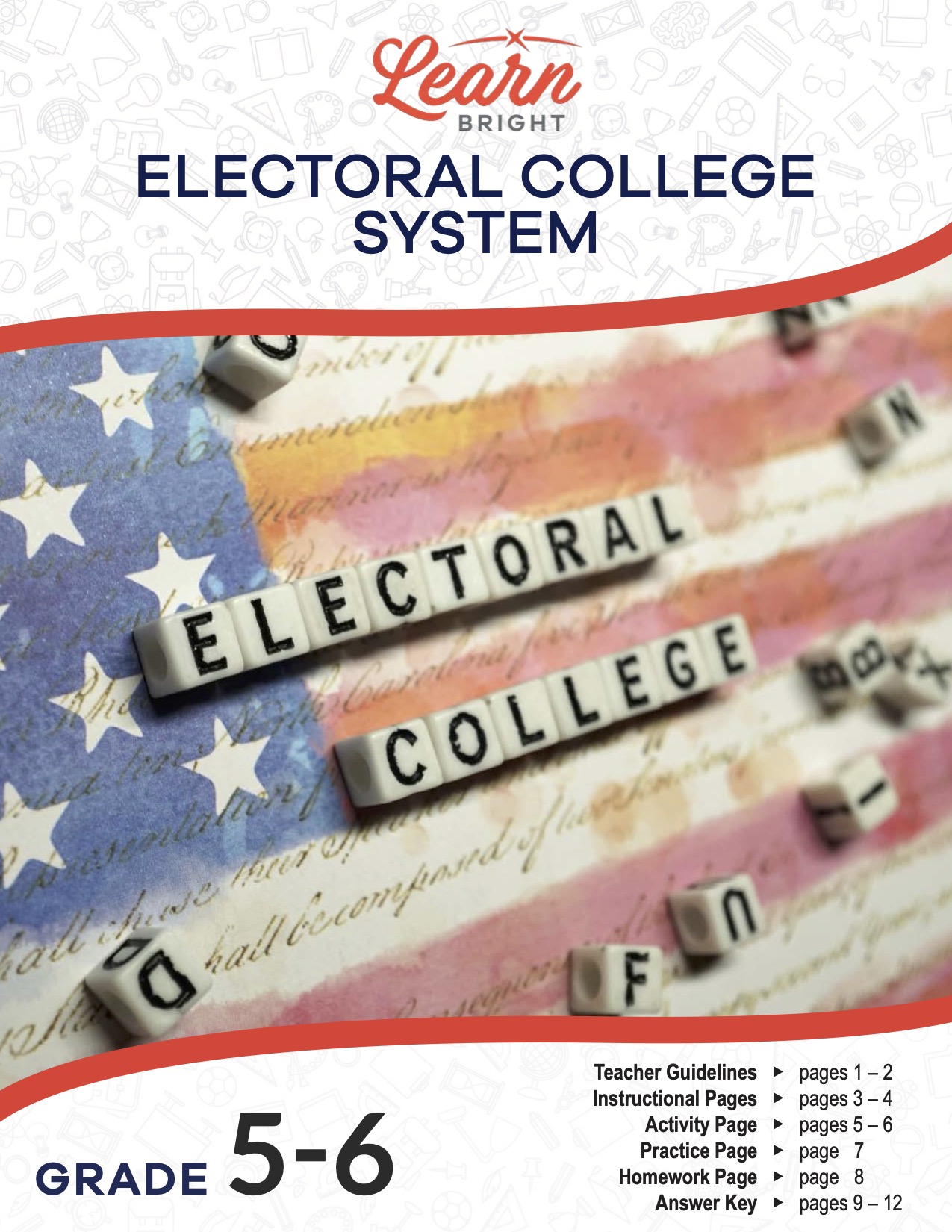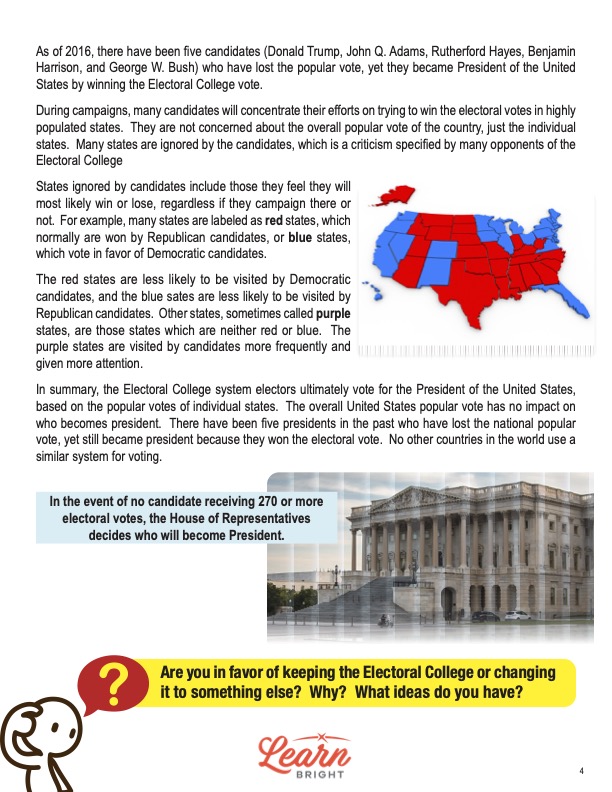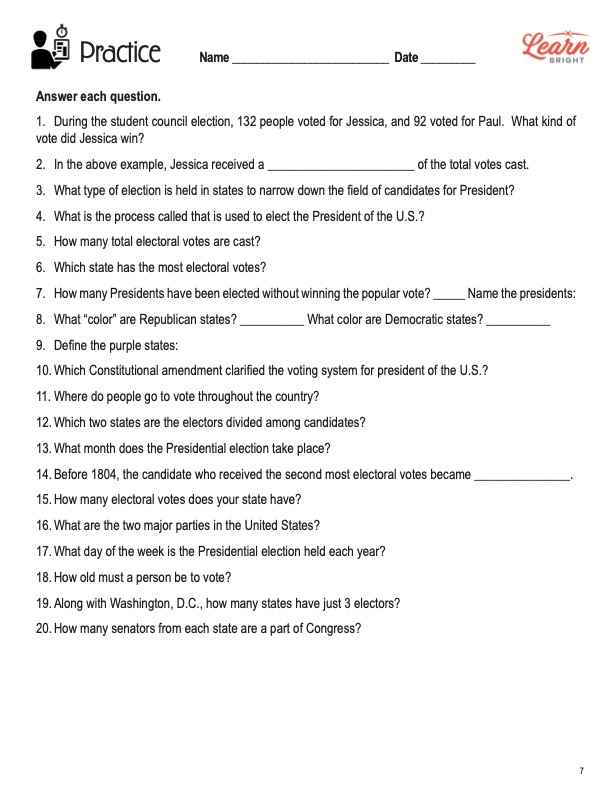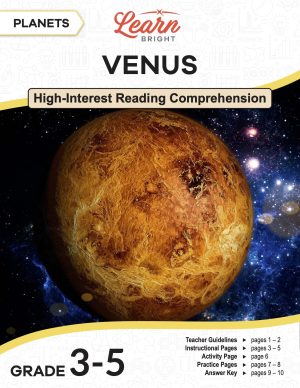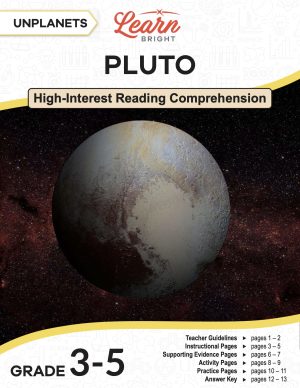Description
What our Electoral College System lesson plan includes
Lesson Objectives and Overview: Electoral College System introduces students to the process America uses to elect the president of the United States. Students will be able to explain how this voting system works and be able to define related vocabulary. They will be able to describe how we use the system to elect the president. This lesson is for students in 5th grade and 6th grade.
Classroom Procedure
Every lesson plan provides you with a classroom procedure page that outlines a step-by-step guide to follow. You do not have to follow the guide exactly. The guide helps you organize the lesson and details when to hand out worksheets. It also lists information in the orange box that you might find useful. You will find the lesson objectives, state standards, and number of class sessions the lesson should take to complete in this area. In addition, it describes the supplies you will need as well as what and how you need to prepare beforehand. The supplies you will need for this lesson are red and blue colored pencils and the handouts. To prepare for this lesson ahead of time, you can gather the colored pencils and copy the handouts.
Options for Lesson
Included with this lesson is an “Options for Lesson” section that lists a number of suggestions for activities to add to the lesson or substitutions for the ones already in it. One optional addition to this lesson would be to hold a mock election in your school using the Electoral College system. Another idea is to invite a local politician to come to your class and talk about how important voting is. Finally, you could have students research how voting systems in other countries work.
Teacher Notes
The teacher notes page includes a paragraph with additional guidelines and things to think about as you begin to plan your lesson. It notes that some students might be aware that we don’t elect the president using the popular vote. However, they may not fully understand how the process does work. This page also includes lines that you can use to add your own notes as you prepare for this lesson.
ELECTORAL COLLEGE SYSTEM LESSON PLAN CONTENT PAGES
The Presidential Election
The Electoral College System lesson plan includes two pages of content. It begins by explaining some of the basic terms and processes related to the Electoral College system. Students will learn that, in the United States, we hold a presidential election once every four years. Either a new president enters the office, or the old president stays for another term. Presidents can serve no more than two terms, whether consecutively or not.
The people who run for president start campaigning a year or more in advance of the election. Sometimes, there are only a few candidates who want to become president. Other times, a lot of people campaign against each other for the office. Most candidates are members of either the Republican or Democratic parties, but there are other political parties as well. However, it is rare for members of other parties to take many votes away from the two main parties.
Students will learn that each state holds a primary election to shrink the field of candidates. After the primaries, the general election for the president takes place every four years in early November. On election day, millions of Americans vote for the person they want to be president. Only people 18 years of age or over can vote. It is possible that a candidate can receive more votes than the other candidate and still lose the election! Winning the popular vote does not necessarily mean that the person wins the election because of the way the Electoral College system works.
A College that Is Not a School
The next section of the Electoral College System lesson plan delves a little deeper into the system itself and how it works. Students will learn that the Electoral College is not a school but the process by which we elect the president. When people vote, they technically vote for an elector rather than the candidate themselves. This elector pledges to vote for the same candidate that the majority of people in their state voted for. All of the electors meet after the election to cast their votes. We collectively refer to these electors as the Electoral College.
The founders of the United States created this system when they wrote the Constitution in 1787. They did this because they did not trust the average people of the country to vote directly for a candidate. They thought that the people would not be well-informed enough to make such a decision. In addition, they believed people would simply vote for an individual from their own state.
At this time, the candidate who received the second most votes automatically became vice president. Today, however, presidential candidates choose their own VPs. Because of this change, the 12th Amendment clarified the process of the Electoral College. It provided that the electors could vote once for president and once for vice president. Students will learn that a candidate has to receive 270 electoral votes to win the presidency out of a total of 538.
Candidates aim to “win states” with large numbers of electoral votes. For example, California has 55 votes! Texas has 38, Florida has 29, and other large states have many votes as well. In the event that no candidate receives 270 or more electoral votes, the decision for who will become president lies with the House of Representatives.
Critics of the Electoral College
Throughout history, there have been five candidates who lost the popular vote but became president anyway because of the Electoral College system. These people are Donald Trump, John Q. Adams, Rutherford B. Hayes, Benjamin Harrison, and George W. Bush. Some people are critical of this system. It encourages candidates to ignore smaller states with fewer votes or states that they are already likely to win or lose. Instead, they concentrate their efforts on the states with the most electoral votes.
In other words, because the popular vote does not determine the president, presidential candidates do not concern themselves with the overall popular vote. They focus on the individual states. They ignore many states because they know they will either win or lose them regardless of their efforts. We call these states red states and blue states.
A red state is a state that a Republican will normally win. A blue state is a state that a Democrat will normally win. Democrats might spend more time in red states and Republicans in blue. However, a candidate for one of these parties could likely ignore whether states are red or blue and just focus on the most populous states or on purple states. Purple states are also called swing states because the electoral vote could swing in either direction.
Key Terms
Here is a list of the vocabulary words students will learn in this lesson plan:
- Primary: an election held in each state to narrow down the field of candidates for president
- Popular vote: the vote that relates to the choices of regular people and not electors; winning this vote does not necessarily equal presidential election
- Electoral College: the group of electors who follow a process that ultimately decides who the president of the U.S. will be every four years
- Elector: the people elected to pledge a vote for the candidate that wins the popular vote of the state they represent
- Red states: states that the Republican candidate will almost certainly win
- Blue states: states that the Democratic candidate will almost certainly win
- Purple states: states that are neither red nor blue that candidates are more likely to visit and give attention to
ELECTORAL COLLEGE SYSTEM LESSON PLAN WORKSHEETS
The Electoral College System lesson plan includes three worksheets: an activity worksheet, a practice worksheet, and a homework assignment. Each one will help reinforce students’ grasp of the lesson content and help them demonstrate their comprehension. The guide on the classroom procedure page outlines when to hand out each worksheet to your students.
STATE ELECTORS ACTIVITY WORKSHEET
For the activity, students will write the number of electors for each state next to each state on a map. They will then follow the directions to color certain states in with different colors. Next, they will add up the number of electoral votes for each color and answer a few additional questions about state electors and electoral votes. Students may also work in pairs for this activity, rather than alone, if you prefer.
QUESTIONS PRACTICE WORKSHEET
The practice worksheet requires students to read and answer 20 questions about the Electoral College. You may or may not allow them to use the content pages for reference. If you choose not to allow it, this worksheet could act as a quiz to test their memory and comprehension.
ELECTORAL COLLEGE SYSTEM HOMEWORK ASSIGNMENT
The homework assignment for this lesson contains three sections. The first section requires students to read various statements and determine whether they are true (T) or false (F). The second section asks them to correctly number the steps of the Electoral College process. For the final section, students must imagine how the Electoral College system would work to elect the president of their school.
Worksheet Answer Keys
This lesson plan includes answer keys for the activity worksheet, the practice worksheet, and the homework assignment. The correct answers for each worksheet are in red to make it easy to compare them to students’ responses. There should only be variation on the final prompt of the homework assignment. All other responses should reflect those on the answer keys. If you choose to administer the lesson pages to your students via PDF, you will need to save a new file that omits these pages. Otherwise, you can simply print out the applicable pages and keep these as reference for yourself when grading assignments.

